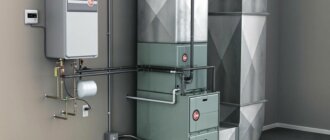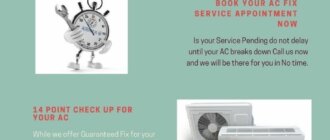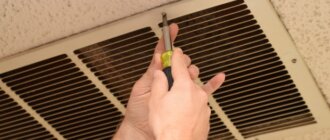How to Recover your HVAC system after a flood
Floods are some of the most devastating natural disasters that can wreak havoc on your property. They not only cause immediate damage to your HVAC system but also pose long-term consequences if not dealt with promptly and correctly.
Recovering your HVAC system after a flood is critical in ensuring its functionality, safety, and longevity.
In this blog post, we will guide you on how to recover your HVAC system after a flood while prioritizing safety measures. Stay tuned for valuable insights into handling immediate damages, calling professionals, repairing or replacing systems, and implementing preventive measures for future floods.
The Impact of Floods on HVAC Systems
Floods can have a devastating impact on HVAC systems, causing both immediate damage and long-term consequences. The water from flooding can easily infiltrate the system through vents or other openings, compromising its integrity.
Immediate damage may include electrical problems caused by short circuits as well as corrosion due to exposure to moisture. Floodwater is often contaminated with all sorts of debris and pollutants that could clog up important components such as blower motors and filters.
Long-term effects of flood damage may not be noticeable at first but could manifest later on in the form of mold growth or rusting parts. This puts added stress on the system, leading to reduced efficiency and higher energy bills over time.
It’s crucial for homeowners to take quick action after a flood event by turning off electricity immediately and seeking professional help for proper HVAC recovery. Failure to do so could result in further damage or even safety hazards.
In summary, floods pose significant threats to your HVAC system both in terms of immediate damage and long-term consequences if left untreated. Being proactive about post-flood recovery is key in preserving the functionality and safety of your home’s heating and cooling system.
Immediate Damage
When a flood occurs, the first thing that comes to mind is usually the physical damage. However, there’s also the immediate damage that can occur to your HVAC system as well.
As water enters your home during a flood, it doesn’t discriminate against which parts of your house it affects. Your HVAC system may take on water and debris through vents or other openings.
This type of immediate damage can result in malfunctions with your heating or cooling systems. The water could cause electrical components to short out or rust, leading to potential hazards for you and your family if left unaddressed.
Furthermore, bacteria and mold growth are common immediate concerns after flooding too- especially when dealing with an HVAC system that has been submerged in contaminated waters. This can lead to respiratory issues for anyone living within the affected space.
Addressing immediate damages from floods in regards to HVAC systems is critical not only for comfort but also safety reasons as well.
Long-Term Consequences
Long-term consequences of flooding on HVAC systems can be devastating and often lead to costly repairs or replacements. Even if your system seems to work fine immediately after a flood, it’s essential to keep an eye out for any long-term effects.
One of the first things you may notice is increased energy usage. This could indicate that your HVAC system is struggling to maintain its efficiency due to flood damage. If left unchecked, this can result in higher electricity bills and decreased comfort levels in your home or business.
Another issue that may arise from long-term flood damage is mold growth. Moisture trapped inside the heating and cooling ducts can create a breeding ground for mold, which not only affects indoor air quality but also poses health risks.
Furthermore, corrosion caused by prolonged exposure to water can cause irreparable damage to various components of your HVAC system. This includes electrical wiring, motors, and compressors which will eventually require replacement or repair.
In summary, even if there are no immediate signs of problems with your HVAC system following a flood event, it’s crucial that you inspect it carefully for any long-term consequences such as increased energy usage or potential mold growth. It’s always best practice to consult with an experienced professional when dealing with post-flood recovery efforts involving HVAC systems.
Safety First: What to Do Immediately After a Flood
Floods can cause significant damage to your home and HVAC system, but safety should always be your top priority. After a flood, there are several steps you should take immediately to ensure your safety.
Firstly, turn off the electricity in your home as soon as possible. Floodwater can carry electrical currents that pose a serious threat of electrocution. Do not attempt to turn off any electrical switches or appliances while standing in water.
Next, wear protective clothing such as rubber gloves and boots before entering the flooded area. The water may contain harmful bacteria or chemicals that could harm you if it comes into contact with your skin.
When removing standing water from your home, never use gasoline-powered pumps indoors due to carbon monoxide poisoning risks. Instead, use electric pumps located outside the house when necessary.
It’s also important to avoid using open flames or smoking near flood-damaged areas since gas leaks are common after floods which can cause explosions.
Once you’ve taken these initial steps for safety purposes only then begin cleaning up any debris left behind by the floodwater. By following these precautions after a flood event will help protect both yourself and others involved in recovery efforts whilst ensuring minimal risk is undertaken during clean-up processes later on down the line.
Turning Off Electricity
Turning off electricity is a crucial step that must be taken after a flood. Water and electricity are not friends, and it’s essential to take precautions to prevent any possible accidents or electrical hazards.
Firstly, before turning off the power supply, make sure you are wearing protective equipment such as rubber boots and gloves. This will reduce the risk of electric shock.
Secondly, locate your home’s main electrical panel. It should be in an easily accessible area like the basement or garage. If you’re unsure about where it is situated, contact an electrician for assistance.
Thirdly, switch off all breakers individually before turning off the main circuit breaker switch. This ensures that every part of your home’s wiring system has been disconnected from power sources.
Wait until authorities declare it safe to turn on electricity again before doing so yourself. Don’t rush into switching everything back on just because things seem dry on the surface; there could still be hidden water damage that may affect your HVAC system’s electrical components.
Taking time to carefully turn off electricity can save lives while protecting valuable electronic appliances from being damaged during post-flood recovery efforts.
Step-by-Step Guide to HVAC Recovery After a Flood
Recovering your HVAC system after a flood can be an overwhelming task, but it is important to take the necessary steps to ensure the safety and functionality of your home’s heating and cooling systems.
Firstly, you should turn off all electricity in the affected area before attempting any repairs or cleanup. This will help prevent electrical shock while working with water-damaged equipment.
Next, remove any standing water from around your HVAC unit and ductwork. Use a wet/dry vacuum or other appropriate cleaning tools to clean up as much water as possible.
After removing excess moisture, it is important to disinfect all surfaces that may have come into contact with floodwater using EPA-approved disinfectants. This will help prevent mold growth and eliminate potential health hazards associated with contaminated air.
Once the area has been disinfected and dried out completely, you can begin inspecting your HVAC unit for damages. Check for loose wiring connections or damaged parts that may need replacement due to exposure to water damage.
If you are unsure how to proceed with repairing or replacing damaged components of your HVAC system after a flood, contact a professional technician who specializes in post-flood recovery services. They can provide expert advice on whether repair or replacement is necessary based on their assessment of the damage done during flooding events.
When to Call a Professional
When it comes to HVAC system recovery after a flood, there are certain steps that homeowners can take on their own. However, some situations require the expertise of a professional. Here’s when you should consider calling in an HVAC technician.
Firstly, if your system was submerged in water for more than 24 hours or has visible damage such as rust or corrosion, it’s best to call a pro. They will have the tools and knowledge necessary to safely assess the extent of the damage and make recommendations based on their findings.
Another instance where you should consider hiring a professional is if there are electrical issues with your system post-flood. Attempting to fix these problems yourself can be dangerous and may result in further damage.
Additionally, if you’re unsure about any aspect of HVAC recovery after a flood, it’s always better to err on the side of caution and contact an expert. They can provide guidance tailored specifically to your unique situation.
Remember: safety is key during this process. Don’t hesitate to reach out for help from professionals who specialize in dealing with flooded HVAC systems.
Replacing vs. Repairing: Making the Right Decision
When it comes to post-flood HVAC recovery, one of the most important decisions you’ll have to make is determining whether your system needs to be repaired or replaced. The answer will depend on a few key factors.
First and foremost, consider the extent of the damage. If your system has suffered significant water damage and subsequent electrical issues, replacement may be necessary. On the other hand, if only minor repairs are needed, repairing your system could be a more cost-effective option.
Another factor to consider is the age of your HVAC system. If it’s nearing the end of its lifespan anyway, replacing it now may save you money in the long run rather than constantly repairing an outdated unit.
It’s also important to weigh energy efficiency considerations when making this decision. A newer unit will likely be more energy-efficient than an older one that requires frequent repairs.
Ultimately, it’s best to consult with a professional HVAC technician who can assess your specific situation and advise you on whether repair or replacement is recommended for optimal safety and functionality.
Preventive Measures for Future Floods
Preventive measures are essential to avoid future flood damage and protect your HVAC system. One of the most effective ways to prevent floods is by investing in a good drainage system both inside and outside your home. Make sure that all gutters and downspouts are clear of debris, so water can flow freely.
Another way to protect your HVAC system from flood damage is by elevating it above ground level. This will reduce the risk of water entering the unit during a flood, which could cause significant damage.
It’s also important to seal any cracks or gaps in your walls, foundation, and windows. These small openings can allow water to seep into your home during heavy rainfall or flooding.
Regular maintenance on your HVAC system can also help prevent future flood damage. Schedule annual inspections with a licensed technician who can identify potential issues before they become major problems.
Make sure you have adequate insurance coverage for any potential damages caused by future floods. Check with your insurance provider about what types of policies are available and make sure you understand what is covered under each option.
By taking these preventive measures now, you’ll be better equipped to handle any potential flooding in the future while keeping your HVAC system safe from harm.
Conclusion: The Importance of Proper Post-Flood HVAC Recovery
Proper post-flood HVAC recovery is crucial to ensure the safety of your family and maintain the functionality of your system. Floods can cause severe damage to HVAC systems, resulting in immediate risks as well as long-term consequences.
If you experience a flood, take immediate action by turning off electricity and following our step-by-step guide for HVAC recovery. It’s essential to know when it’s time to call a professional and whether replacing or repairing is the best option.
Preventive measures are critical for future floods. Consider elevating your HVAC equipment, installing backflow preventers, and maintaining proper drainage around your home.
By taking these steps and being prepared for potential flooding events, you’ll be able to recover from any damages quickly while ensuring that your HVAC system continues to operate efficiently and safely throughout its lifespan.



